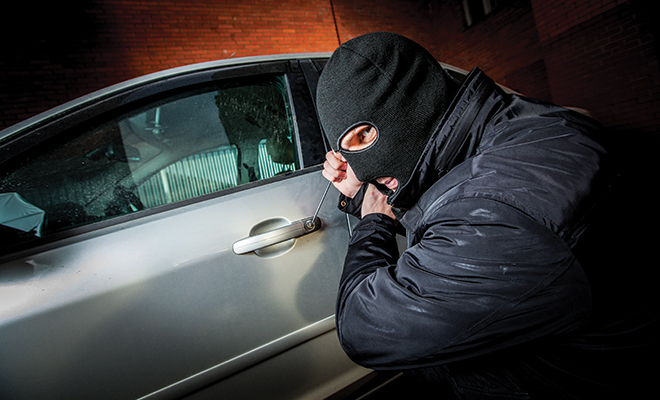
Grand Theft Auto: Is Your Vehicle at Risk?
It’s a sinking feeling. You leave the store, return to the parking lot, and your car isn’t where you left it. Or it’s missing from your driveway in the morning. Yes, you eventually figure out that it’s been stolen. What can you do to prevent ending up with this hassle in your life?
Be Aware
The Honda Accord leads the National Insurance Crime Bureau’s top ten list of the most stolen cars from all model years, with 53,995 stolen in 2013, followed by the Honda Civic at 45,001. Rounding out the list were the Chevy Silverado, Ford F-150, Toyota Camry, Dodge/Ram Pickup, Dodge Caravan, Jeep Cherokee, Toyota Corolla and Nissan Altima. The top-selling older cars are actually stolen more often, usually sent to chop shops or sold for the scrap metal value. In comparison, pilfered newer cars are frequently resold intact with doctored paperwork, often outside the United States. The Nissan Altima topped the list of the most stolen model year 2013 cars, with 810 stolen, followed by the Ford Fusion, Ford F-150, Toyota Corolla, Chevrolet Impala, Hyundai Elantra, Dodge Charger, Chevrolet Malibu, Chevrolet Cruze and Ford Focus.
Thanks to the abundance of new anti-theft technology, newer models are harder to hot-wire and easier to trace if they’re stolen. The FBI notes a slight decrease in theft rates, but it’s still a $4.5 billion a year industry. The NICB suggests some simple tips in a layered approach to the owner’s vigilance and preparation in preventing theft.
Use Common Sense
Lock your car; half of all stolen vehicles are left unlocked. Take your keys; if your set contains a home key, you’ve just given access to your home as well. Program your home address in the GPS under a name other than “Home.” Park in well-lit areas and attended lots; thieves work at night and don’t like witnesses. Park with your wheels turned toward the curb and always engage the emergency brake. If you have a garage, use it, and lock the garage door. Additionally, make sure the garage door leading into the house is locked.
“Stealing a vehicle is very difficult with today’s anti-theft technology and leaving the keys in the vehicle is an open invitation for the opportunistic car thief,” said National Insurance Crime Bureau President and CEO Joe Wehrle. Leaving your vehicle running to warm up on a cool morning could lead to your making that dreaded report to the insurance company and earning a corresponding increase in your insurance rate.
Make Noise
If you’ve ever walked too closely to a car in a parking lot that warned you to step back, you’ve encountered one of these audible alarms. Other devices include steering wheel and steering column locks, brake locks and tire locks. Glass break or vehicle tilt sensors provide additional attention to an attempted theft and are reasonably priced. Slightly more passive protectors include a protective window laminate and identification decals on various surfaces. To assist in recovery of a stolen vehicle, have the vehicle identification number etched on windows or have microdots imprinted with identification information applied to surfaces.
Immobilize It
The third layer of protection is a device that prevents the thief from bypassing the ignition and hot-wiring the vehicle. Smart keys require a handshake between the ignition system and the key before the car will start. The remote locking feature in higher-end cars depends on the proximity of the key fob to the car; the passive door locking system activates when the key fob moves a certain distance.
Track It
The GPS- and RF-enabled technology that keeps theft rates down on newer vehicles is nevertheless available for older models. Systems such as LoJack®, VectorTrac or Guidepoint™ are aftermarket solutions that protect older cars and can work directly with law enforcement to track and recover a stolen vehicle. For example, Guidepoint’s GPS-1 records the vehicle’s exact location when the key is removed from the ignition. If the vehicle is moved without being started by the key, an electronic signal is sent to the tracking station, which contacts the owner to verify if the car has been stolen.
It’s a good precaution to keep a copy of your vehicle registration and insurance card in your wallet and at home as well. You’ll be able to quickly provide this information to law enforcement and your insurance agent.
Sell Smart
Law enforcement agencies report that thieves using counterfeit cashier’s checks or money orders purchase cars, frequently on weekends, when the banks are closed. In a few days, after the buyer and car are long gone, you are notified by your bank that the tender is no good. It’s always wise to take payment at a bank where the funds can be verified.
Protect your investment and hard-earned dollars; follow the above common-sense tips and reduce your risk of becoming a victim. HLM
Sources: aata.org, azinsurance.org, combatautotheft.org, cnet.com, fbi.gov, guidepointsystems.com, lojack.com, nicb.org and vectortrac.com.







